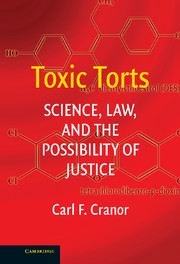Book contents
- Frontmatter
- Contents
- Preface
- 1 The Veil of Science over Tort Law Policy
- 2 Legal Background
- 3 Institutional Concerns about the Supreme Court's Trilogy
- 4 Studies of Toxicity and Scientific Reasoning
- 5 Excellent Evidence Makes Bad Law: Pragmatic Barriers to the Discovery of Harm and Fair Admissibility Decisions
- 6 Science and Law in Conflict
- 7 Enhancing the Possibility of Justice under Daubert
- 8 Is Daubert the Solution?
- Bibliography
- Index
3 - Institutional Concerns about the Supreme Court's Trilogy
Published online by Cambridge University Press: 08 January 2010
- Frontmatter
- Contents
- Preface
- 1 The Veil of Science over Tort Law Policy
- 2 Legal Background
- 3 Institutional Concerns about the Supreme Court's Trilogy
- 4 Studies of Toxicity and Scientific Reasoning
- 5 Excellent Evidence Makes Bad Law: Pragmatic Barriers to the Discovery of Harm and Fair Admissibility Decisions
- 6 Science and Law in Conflict
- 7 Enhancing the Possibility of Justice under Daubert
- 8 Is Daubert the Solution?
- Bibliography
- Index
Summary
In Daubert, the Supreme Court correctly saw that lower courts had reviewed the admissibility of expert testimony and its foundation on the basis of a principle – the Frye “general acceptance” test – that had been superseded by the more liberal admissibility guidance of the Federal Rules of Evidence. At the same time, when it sought to articulate guidance for this activity, it heightened the gatekeeping duties of judges. However, in doing this, it entered intellectual territory that is not readily accessible to judges with their typical training.
The Supreme Court did not mention and seemingly disregarded its own decision of a decade earlier in Barefoot v. Estelle. This decision had held that cross-examination and jury assessment of witnesses' credibility and reliability were sufficient to protect a criminal defendant in a death penalty case against dubious and unreliable expert testimony that was widely criticized by the expert's own profession. By the time Daubert was decided in 1993, instead of merely rejecting Frye, as Chief Justice Rehnquist argued in dissent, and going beyond the plain language of the Federal Rules of Evidence, it created a “reliability” screen for expert testimony. This contrasted with Barefoot v. Estelle and with much of the previous application of the Frye test. In many jurisdictions, the Frye test only applied to generic tests, studies, technological devices, and scientific procedures that provided the foundation of scientific testimony, not to scientific opinions or the inferences of scientists.
- Type
- Chapter
- Information
- Toxic TortsScience, Law and the Possibility of Justice, pp. 62 - 90Publisher: Cambridge University PressPrint publication year: 2006



